
Now that the government of Bangladesh seems finally to have recognized the fact that the Rohingya will be in the country for the long haul, it has started looking for long-term options for managing the huge refugee population.
Authorities in Dhaka are correct that holding more than one million people in cramped conditions at Cox’s Bazaar is not a sustainable solution. But the authorities are wrong to believe that moving some of them to Bashan Char will help to solve the problem.
Cox’s Bazaar has been struggling with poor and hopelessly overwhelmed infrastructure. In this respect, Bashan Char might appear to be a better option. Bangladesh has invested more than $300 million in building facilities there that are, indeed, of much higher quality than anything in Cox’s Bazaar.
Some have suggested that another motivation for moving some of the Rohingya is the geological instability in a region where the government says there is a high risk of landslides. Yet if that is indeed a good reason to move people away from Cox’s Bazaar, it is certainly not a good reason to move them to Bashan Char, of all places.
The silt island in the Bay of Bengal is very isolated, about 20 miles from the coast. It is, on the whole, unsuitable for agriculture and could scarcely sustain more than 300,000 people — in the most extreme scenario. This means that any people who end up living on the island will probably remain permanently economically dependent on Bangladesh and/or international aid for food and other essentials.
They will also be at the mercy of monsoon flooding every year, and the possibility that the whole island might eventually be submerged by rising sea levels resulting from climate change.
Unfortunately, we might now be in the situation of having to make a choice between preserving the distinct cultural identity of the Rohingya, and saving the lives of a million human beings.
Dr. Azeem Ibrahim
By any measure, then, Bashan Char is at least as precarious a place to settle people as Cox’s Bazaar.
There are, unfortunately, no good options when deciding how to approach this issue. The reason why the Bangladeshi government has restricted the refugee population to Cox’s Bazaar up until now, and why they thought Bashan Char would be the next-best option, is because Bangladesh is already one of the most densely populated countries in the world. It has a growing population and it is going to be one of the parts of the world worst affected by ongoing sea-level rises. The only other places to put the million-plus refugees would be among already crowded local communities.
There are a number of reasons why this is extremely undesirable. For one, it could trigger a nativist backlash that might affect the safety of refugees in the medium term. For another, if the Rohingya were to be mixed in with local populations, we might expect that they would lose their distinct cultural identity within a generation or two — thus completing the genocide being carried out against them.
Unfortunately, we might now be in the situation of having to make a choice between preserving the distinct cultural identity of the Rohingya, and saving the lives of a million human beings.
If that is the decision we are faced with, it seems to me that we must save lives. It therefore looks as if the most humane thing we can do in the current circumstances — short of going to war with Myanmar over its genocidal actions and carving out an independent territory for the Rohingya — is to plead with Bangladesh, and neighboring countries, to begin integrating the refugees into their populations, and to offer those countries any financial, political and logistical support they need to do so.
This is a truly painful choice. To make it is to acknowledge the genocide is a fait accompli and essentially irreversible. But the need to ensure the well-being of more one million people seems to outweigh the heartbreak of pursuing this path.
Dr. Azeem Ibrahim is the author of “The Rohingyas: Inside Myanmar’s Genocide” (Hurst, 2017)
Disclaimer: Views expressed by writers in this section are their own and do not necessarily reflect Arab News" point-of-view











